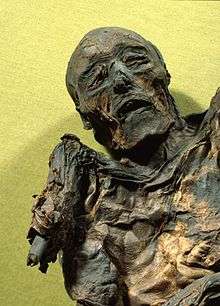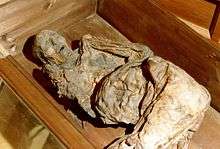Huldremose Woman
| Huldremose Woman | |
|---|---|
 Upper body of the Huldremose Woman, pictured in 1978 | |
| Died | 160 BCE - 340 CE |
| Body discovered |
15 May 1879 Ramten, Jutland, Denmark |
| Other names | Huldre Fen Woman |


Huldremose Woman, or Huldre Fen Woman, is a bog body recovered in 1879 from a peat bog near Ramten, Jutland, Denmark. Analysis by Carbon 14 dating revealed the woman had lived during the Iron Age, around 160 BCE to 340 CE. The mummified remains are exhibited at the National Museum of Denmark. The elaborate clothing worn by Huldremose Woman has been reconstructed and displayed at several museums.[1]
Discovery
On 15 May 1879, the body was discovered by Niels Hanson, who was a school teacher in Ramten, Denmark, after digging a meter through the peat. Hanson then reported the find to a fellow teacher, who notified police as well as a pharmacist, who moved the body to a nearby barn for examination. The national museum of Copenhagen later surrendered the corpse.[1]
Bioarchaeology
The body was found with the legs bent behind the back, with a nearly severed right arm. It is thought that the arm was damaged by a shovel during excavation.[2] Apart from this, the corpse was well intact.
Before the woman died, she had broken one of her legs, although it had healed before she died.[2] She wore a plaid cape, a scarf, and skirt, all made of wool. A comb and headband were found as well.[1][2] Lacerations on one of the feet were thought to be post-mortem injuries inflicted by a shovel until they were then evaluated to have happened near the time of death.[3] A rope was also found around the neck of the body, which suggests that she was hanged or strangled, although it may have been a necklace.[2]
The body was reexamined non-invasively in 1990[3] and a dietary analysis was conducted in 1999.[4] Radiography showed hair stubble on the scalp as well as the remains of the brain inside the cranium. The bones were demineralized, like many other bog bodies. The dietary analysis consisted of two samples of the gut contents, revealing that the woman's final meal had been rye bread.[3]
References
- 1 2 3 Gleba, Margarita; Mannering, Ulla (2010). "A thread to the past: the Huldremose Woman revisited". Archaeological textiles newsletter. Leiden (50): 32–37. ISSN 0169-7331.
- 1 2 3 4 "Bog bodies of Europe". Wikispaces.com. Retrieved 14 May 2012.
- 1 2 3 Gill-Robinson, Heather (2005). The Iron Age Bog Bodies of the Archäologische Landesmuseum Schloss Gottorf. pp. 65–68.
- ↑ Gill-Robinson, Heather (2005). The Iron Age Bog Bodies of the Archäologische Landesmuseum Schloss Gottorf. p. 32.
Coordinates: 56°26′40″N 10°37′50″E / 56.44444°N 10.63056°E
External links
- The woman from Huldremose at National Museum of Denmark
- Clothing and Hair Styles of the Bog People on archaeology.org